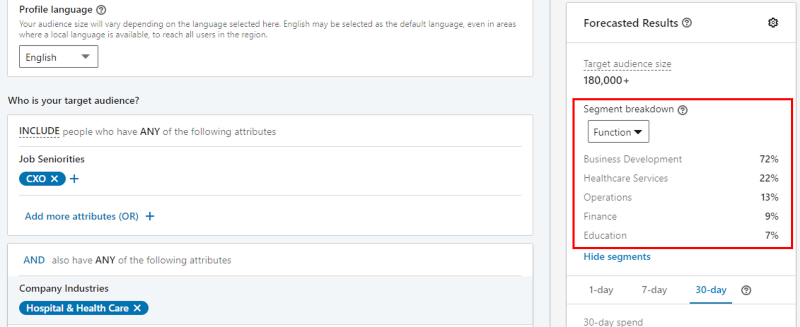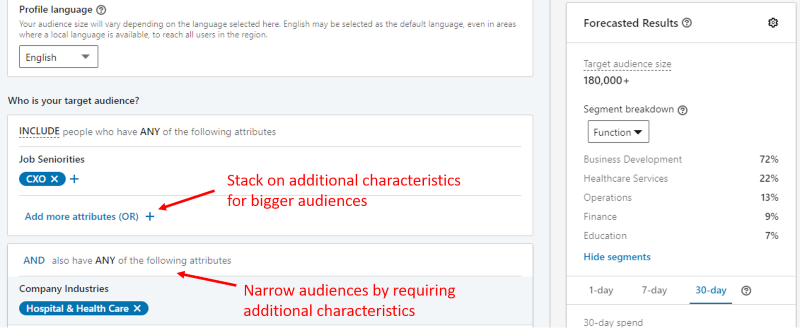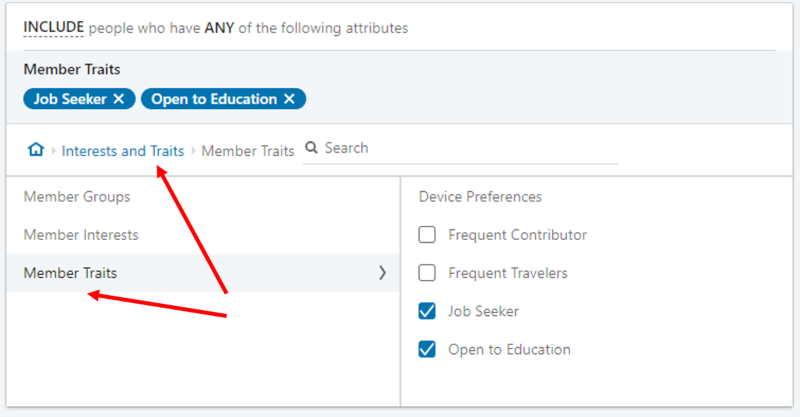5 New Features That Has LinkedIn Advertising Stepping Up Its Game
If you haven’t noticed yet, the LinkedIn advertising platform has been stepping up its game. Out of all the major digital ad platforms that we deal with (Google, Bing, Facebook, etc.), LinkedIn’s platform and capabilities has historically been the worst in my (and many others) opinion. This is of course outside of the vastly superior B2B audience targeting capabilities they offer, which is the main reason they get advertisers using the platform for campaigns in the first place.
But now they’ve seemed to start addressing major customer pain points from the past in increasing measure…and I’m loving it! Here I’m going to point out 5 of the most recent major feature additions that have made using the platform better than it’s ever been.
Segment Breakdown
When you enter audience characteristics in the campaign builder, the audience forecasting tool will populate with a feature called Segment Breakdown. This tool shows you the make-up of your target audience right from the campaign creation dashboard. You can use the drop-down menu to surface specific professional characteristics – like top industries, years of experience, or company sizes that your chosen audience contains. The chart then shows you what percentage of your chosen audience fits specific categories under each of those characteristics (see image below).
Let’s say I’m a company that helps with the construction of hospitals and other healthcare facilities and I want to reach people that have an influence on making decisions for expansion. Immediately, I think an obvious target audience of mine would be CxOs of businesses in that industry.
So, I go into the Audience Builder and choose the Job Seniority of CxO and the Company Industry of Hospital & Healthcare.
But my problem here is that there are likely more members out there that would be good for me to target than just this audience. What the Segment Breakdown tool allows me to do is choose what professional characteristics I want to cross-reference for my audience.
When I choose Job Function like I did above, I can see that a combined 86% of my audience is labeled with the Job Function of Business Development or Operations. Since these are both departments of the business that may be involved in the buying decision for what I offer, I now have an idea for the start of a new audience that will reach more people.
My base audience of CxOs job seniority in the Hospital & Healthcare industry had an audience size of 180,000. If I create a new audience that focuses on the Job Functions of Business Development & Operations in the Hospital & Healthcare industry (instead of CxOs), my audience size goes up to 1.1 million.
This is very helpful if I want to reach a bigger (and cheaper) audience with great content and fill my remarketing audiences with people that show interest (thereby self-identifying as part of who I want to reach) so I can push them down my marketing funnel later on.
Boolean Targeting Logic
Since the beginning of LinkedIn’s ad platform, targeting was built on “And” logic; meaning every new characteristic you added to your audience would narrow it down to members that had both characteristics. But now there’s “And/Or” targeting that gives you more flexibility with your targeting combinations. Now you can actually expand your audience targeting in a campaign by choosing “Or” between your characteristics.
In our example above, this would be the difference between targeting members who were CxOs in the Hospital & Healthcare industry and targeting members who were either CxOs in ANY industry or have ANY job in the Hospital & Healthcare industry. You can see how different these are, so you have to be careful that you choose the right characteristics. For the offer in my example, choosing “Or” here would be a disaster :).
The issue with only using “And” logic before was that it was hard to create large enough audiences for some advertisers to go after without having the result of a ton of campaigns to manage. You can imagine if you had one campaign for each characteristic – location – objective – ad type combination. With “Or” targeting added, you can group together multiple characteristics for larger audience sizes and easier campaign management.
Of course, the larger your audiences get, the less relevant they get in general. So, you’ll still have to think about how well your characteristics match to possible prospects when you use “Or” targeting. It’s great to have bigger audiences, but there has to be a balance or you’ll just spew money to people that aren’t really interested in what you have to offer.
Member Interest & Traits
These are labels in the audience builder that the LinkedIn platform gives to members based on or inferred from their actions and engagement with specific online content on LinkedIn and from Bing searches. So, you could say they’re similar to Custom Intent Audiences from Google.
In promoting an open house for a university, I used the Member Traits of Job Seeker and Open to Education.
Similar to targeting by Interests in Facebook, these audiences are rarely going to be your best options. I assume they will keep adding more choices in the future and they can be good options for adding reach to specific campaigns if you have issues with that from the target audiences you build yourself.
Audience Templates
LinkedIn audience templates are sets of pre-populated targeting options that help advertisers reach specific targeted audiences more quickly and easily. Here you can see what some of the options are…
There are some types of advertising on LinkedIn that are very common (like recruiting), as well as some types of audiences that get targeted frequently (like Financial Decision Makers). LinkedIn recognized this and provided a way for us to quickly choose an audience template to start with to speed up the process of building the audiences we may normally target. You can then layer on other characteristics to these templates if you’d like to make your audiences more targeted.
Having a client in higher education, I was delighted to see one called “New To Job Market” as those are members who can be prime candidates to choose to do more education, but there was no way to target them previously.
Engagement Retargeting
You now have the ability (if you don’t see it yet, just wait about a month and check again) to create audiences based on their engagement with your content on the platform if they interacted with a video ad or lead gen form. The window for engagement with these is anywhere from 30-365 days.
One of the major issues with their ad platform up to this point is that B2B buying cycles are longer and require companies to keep their prospects (or current customers) warm and engage them over longer periods of time. Social media users also prefer not to leave the platform when they’re on it.
This means building retargeting audiences was swimming upstream as you had to get people to go to your website to get them in an audience. With the cost of LinkedIn, many advertisers can struggle to drive enough traffic to build a remarketing audience worth the cost to get users to their website. With this new feature, they no longer have to. They can deliver high-value content and offers to audiences based on what they’ve engaged with in the past and focus their efforts on the prospects that are most likely to purchase in the future when the time is right.
It’s no doubt that if you’re trying to drive results for your company or clients with LinkedIn advertising, trying out one or more of these new features to build and execute your strategy may pay off.




